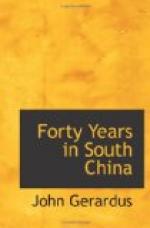The present Manchu dynasty seized the Dragon throne in 1644. For one hundred and fifty years China enjoyed comparative peace and prosperity. The emperor Kang-hi and his grandson Keenlung, each reigned sixty years, to the Chinese a manifest token of Heaven’s favor. The past one hundred years have been troublous. There has been internal strife. There have been momentous issues to settle in the opening of China’s gates to the outside world. When she needed Emperors of the broadest statesmanship, she has had to blunder along with mediocre men or bend an unwilling neck under the sway of puppets. Had it not been for her great Prime Ministers, such as Prince Kung and Li Hung Chang, the days would have been fuller of dark-presaging omens and their disastrous fulfillment.
The beginning of this century found a secret society in existence known as the “Triads,” whose avowed object was the expulsion of the Manchus and the restoration of the Mings. In 1803 the emperor Kiaking was attacked in open day while being carried in a chair of state through the streets of Peking. He was saved by his attendants, several of whom lost their lives.
In 1851 the Tai-ping Rebellion began. The fuel that fed the flame was various. It was reaction against oppressive government. It was iconoclasm inspired by a spurious Christianity. It was pride of race that would not tolerate a Manchu on the throne. For fourteen years China staggered under this awful scourge. Whole provinces were devastated and almost depopulated. For a long time the issue was uncertain. At length the united strength of foreigners and Chinese battered the serpent’s head and destroyed its vitals.
While the boa of rebellion was stretching itself across the heart of the empire a whole brood of little serpents were poisoning and devouring other outlying provinces. An insurrection was organized in the neighborhood of Amoy early in 1853. Mr. Talmage writes fully concerning it.
THE “LITTLE KNIFE” INSURRECTION.
Jan. 25, 1853. To the Sunday-school, Flushing, New York.
“The streets of Amoy are very narrow. The widest are only a few yards wide. At very short distances apart, there are gates across the streets. The object of these gates, and the principal cause of the streets being so narrow, are to protect the inhabitants from gangs of thieves. In the winter season, when men have more leisure and more temptation to plunder, these gates are closed every night. During the present winter the people seem to have had more fear of robbers than usual. Old gates have been repaired and many new gates have been built. The inhabitants of a Christian land, like America, do not fear to live alone in the country without any near neighbors. But in this region a house standing alone in the country is scarcely ever seen. The people always collect together in villages or towns or cities. The villages are usually provided with small watchtowers, built of stone or brick, in which a few men may sleep as sentinels to give notice of the approach of robbers, and to fire on them. Even in the towns and cities you seldom see a dwelling-house with an outside window. If there be such a window, it is usually guarded by slabs of granite, or by mason-work with only small openings, like the windows of a prison, so that a person cannot pass through.”




